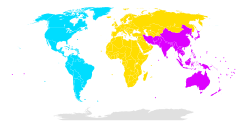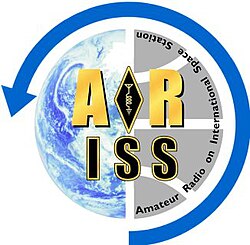ARISS


Das Projekt ARISS (englisch Amateur Radio on the International Space Station, deutsch: Amateurfunk auf der Internationalen Raumstation) ermöglicht Schülern mit dem Amateurfunkdienst über Satelliten Funkkontakte mit Astronauten in der Raumstation ISS. Ehrenamtlich tätige Funkamateure stellen Verbindungen zwischen Schulen und der Raumstation her.
Die erste Phase von ARISS fand bereits im ersten Modul der ISS Sarja statt, sodass bereits zwei Jahre nach dessen Start der erste Schulkontakt durch den Astronauten William Shepherd während der ersten ISS-Mission am 21. Dezember 2000 durchgeführt werden konnte.[1] Auf dem Sarja-Modul befindet sich auch der APRS-Digipeater. Vorläufer des Projekts waren das Shuttle Amateur Radio Experiment und Space Amateur Radio Experiment (jeweils SAREX).
Die ARISS-International Working Group befindet sich in Silver Spring, MD, Vereinigte Staaten.[2]
Antennen der ISS

Im Rahmen der ARISS Phase 2 wurden während verschiedener Außenbordeinsätze am Swesda-Modul mehrere Antennen für Kurzwelle, VHF, UHF sowie das L-Band installiert. Für die Amateurfunkstelle im Columbus-Modul wurden im Oktober 2007 an dessen Mikrometeoriten-Schutzschild Antennen für das S- und L-Band installiert. Die ursprünglich geplanten Antennen für UHF wurden aus Kostengründen nicht installiert. Die Kosten für die Installation der Antennen am Columbus-Modul übertrafen 100.000 Euro.[1] Die Technische Universität Breslau beantragte beim polnischen Ministerium für Wissenschaft und Entwicklung einen Fonds, der 14.000 Euro der Kosten deckte.[1] Weitere 69.000 Euro wurden von der ARISS aus Spenden finanziert.
HamTV
Am 13. April 2014 erfolgte die abschließende Konfiguration des HamTV, eines DATV-Systems auf dem Modul Columbus der Internationalen Raumstation ISS. ISS-Kommandant Kōichi Wakata (Rufzeichen KC5ZTA[3] betrieb den DATV-Sender im Columbus-Modul unter dem belgischen Rufzeichen OR4ISS. Die Sendung der ARISS-Antenne 43 wurde am Boden von der französischen Amateurfunkstation F6DZP auf 2395 MHz im 13-cm-Amateurfunkband empfangen und auf der Videoplattform YouTube veröffentlicht.[4] Das HamTV-System soll bei künftigen Schulkontakten nicht nur Ton, sondern auch Livebilder aus der Raumstation liefern. Der erste Test-Einsatz sollte am 1. September 2014 beim ARISS-Funkkontakt mit dem Gymnasium Siegburg, Nordrhein-Westfalen stattfinden, wurde jedoch abgekündigt.[5] Am 11. Februar 2016, während der ISS-Expedition 46, fand der erste erfolgreiche Einsatz von HamTV während eines Schulkontakts zwischen dem ISS-Bordingenieur Timothy Peake (Rufzeichen KG5BVI[6]) und der Mädchenschule Royal Masonic School for Girls aus Rickmansworth, Großbritannien statt.[7]
Frequenzen

| 2-Meter-Band | Betriebsart | Nutzung | ITU-Region | |
|---|---|---|---|---|
| Downlink | Uplink | |||
| 145,800 MHz | 145,200 MHz | Fonie in FM | Crew-Kontakt | Region 1 |
| 145,800 MHz | 144,490 MHz | Fonie in FM | Crew-Kontakt | Region 2 und 3 |
| 145,800 MHz | SSTV in FM | SSTV-Downlink einer Außenbordkamera | weltweit | |
| 145,825 MHz | 145,825 MHz | FM mit 1200 Baud AFSK | APRS-Digipeater | weltweit |
| 2-Meter-Band / 70-Zentimeter-Band | Betriebsart | Nutzung | ITU-Region | |
| Downlink | Uplink | |||
| 437,800 MHz | 145,990 MHz | Fonie in FM mit 67 Hz CTCSS | Crossband-Repeater | weltweit |
| 2-Meter-Band / 23-Zentimeter-Band | Betriebsart | Nutzung | ITU-Region | |
| Downlink | Uplink | |||
| 145,800 MHz | 1269,650 MHz | Fonie in FM | Crossband-Repeater | weltweit |
| 70-Zentimeter-Band | Betriebsart | Nutzung | ITU-Region | |
| Downlink | Uplink | |||
| 437,550 MHz | 437,550 MHz | Fonie in FM | Crew-Kontakt Simplex | weltweit |
| 13-Zentimeter-Band | Betriebsart | Nutzung | ITU-Region | |
| Downlink | Uplink | |||
| 2,395 GHz | DATV Symbolrate: 2,0 MS/s | HamTV | weltweit | |
Weblinks
- Status des HamTV
- Aktueller Status der Station
- Offizielle europäische Website
- ARISS-Schulkontakte von ESA-Astronaut Dr. Alexander Gerst zum Nachhören
- APRS-Amateurfunkstationen, welche von der ISS digipeated wurden
- Offizielle internationale Website
Einzelnachweise
- ↑ a b c ARISS antennas installaled on Cokumbus. 20. Oktober 2007, abgerufen am 8. Januar 2013 (englisch).
- ↑ International Space Station Ham Radio (also known as Amateur Radio on the International Space Station (ARISS))
- ↑ KC5ZTA in der Datenbank der Federal Communications Commission (FCC))
- ↑ HamTV-Test
- ↑ ARISS contact planned with Gymnasium Siegburg, Germany. Abgerufen am 1. April 2019 (englisch).
- ↑ KG5BVI in der Datenbank der Federal Communications Commission (FCC)
- ↑ Gaston Bertels, ON4WF: HamTV on the ISS. HamTV School Contact – A World First! ARISS, abgerufen am 14. März 2017 (englisch).
Auf dieser Seite verwendete Medien
Logo of the non-profit organization "Amateur Radio on the International Space Statio".
Autor/Urheber: NASA Goddard Space Flight Center, Lizenz: CC BY 2.0
Employees were invited to listen to a question-and-answer session between students from the Goddard Child Development Center, local students and residents aboard the International Space Station on Thursday, Sept. 13, beginning 12:40 p.m. EDT. This was a rare opportunity, via amateur radio, for students to talk directly to astronaut Akihiko Hoshide about living and working aboard the orbiting facility.
Attending this event were students from the Goddard Child Development Center, the Robert Goddard French Immersion School, and the Prince George’s County Howard B. Owens Science Center. This was made possible through Amateur Radio on the International Space Station (ARISS), a cooperative venture among NASA and other international space agencies that coordinates scheduled, radio contacts with students and astronauts aboard the station.
Teachers across varying content areas have incorporated lessons regarding space, astronomy, NASA, and the space station into their subject curriculum. ARISS and Teaching From Space, a NASA education initiative, encourage participating schools to lay such groundwork as part of its goal to instill interest in science, technology, engineering and math (STEM) subjects and careers among students.
The ARISS radio contact is one in a series with educational activities in the U.S. and abroad to improve teaching and learning in STEM. This project promotes learning opportunities and builds partnerships with the education community using the unique environment of human spaceflight.
NASA Goddard Space Flight Center enables NASA’s mission through four scientific endeavors: Earth Science, Heliophysics, Solar System Exploration, and Astrophysics. Goddard plays a leading role in NASA’s accomplishments by contributing compelling scientific knowledge to advance the Agency’s mission.
Follow us on Twitter
Like us on Facebook
Find us on InstagramA map of the world divided into International Telecommunication Union regions.
Russian cosmonaut Maxim Suraev, Expedition 22 flight engineer, conducts a ham radio session in the Zvezda Service Module of the International Space Station with students, alumni and faculty of Kursk State Technical University.
Expedition 25 commander Col. Doug Wheelock in the Zvezda Service Module in amateur radio contact with Mike McConnell Ph.D. in Texas
Susan J. Helms, Expedition Two flight engineer, talks to amateur radio operators on Earth from the HAM radio workstation in the Zarya module of the International Space Station (ISS).





